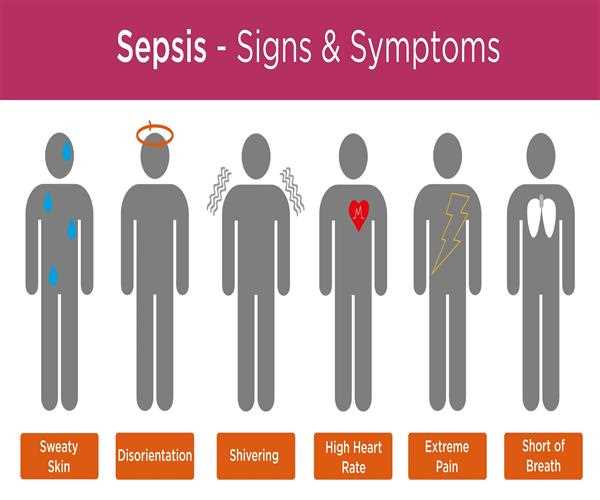Sepsis is the prominent cause of preventable deaths across the world. Sepsis can cause deaths of one in every four persons. It may lead to permanent disability in its survivors. According to The Surviving Sepsis Campaign Bundle: 2018 Update it is necessary that nursing and other clinical staff attend and respond to a sepsis patient within an hour of the occurrence of the sepsis indications.
The role of bedside nurses is very prominent in taking care of sepsis patients. They are the ones who should act with immediate steps in taking decisive action after studying the sepsis patient from a near condition and implement special treatment bundles.
What is Sepsis?
Under normal conditions of an infection in a human, the body releases chemicals to fight the infection. In this process, it releases specific chemicals into the bloodstream, leading to inflammatory responses that help the body fight the infection and regain the normalcy.
In the case of sepsis, the level of these chemicals goes out of balance and severely disrupts the functioning of multiple organ systems in the body. This causes a kind of a shock to the body, often termed as septic shock. In such a condition, the blood pressure immensely drops and may ultimately lead to the death of the patient.
Singer et.al defines sepsis as a life-threatening organ dysfunction caused by a deregulated host response to infection.
What happens during sepsis?
During sepsis, despite sufficient fluid resuscitation, persistent hypotension is observed, forcing the patient’s body into a condition called Septic shock. All the circulatory and cellular fluids reach abnormal levels and can lead to the death of the individual.
Singer et al. states that during a septic shock, the persisting hypotension requiring vasopressors to maintain MAP (mean arterial pressure) >65mmHg and having a serum lactate level >2mmol/L despite adequate volume resuscitation.
Why sepsis occurs?
Though the underlying cause of sepsis is infection mainly in the abdomen, lungs, kidney or blood, the existence of additional morbidities too can cause sepsis condition. There is no age or sex factor observed for being affected with sepsis – males and females, young and old – all individuals are equally potent to develop sepsis.
In persons with weak immune systems and those who are already suffering from other medical problems are more likely to suffer from sepsis.
How to identify sepsis?
In cases of sepsis, the following symptoms can be observed:
- An abnormal change in body temperature causing shivering, coldness, or fever
- Unbearable pain and discomfort
- Skin discoloration
- Unable to breathe normally and feeling short of breath
- Abnormal WBC count
- Elevated liver secretions
- Change in cerebral functions
What do nurses attending sepsis patients need to know?
Early identification and speeded up treatment can help save a sepsis patient. Sepsis treatment includes the usage of antibiotics, IV fluids and vasopressors.
- The attending nurse should have a report of lactate levels, previous antibiotic administration history and blood culture reports as immediate as possible after identifying sepsis conditions.
- Within 3 hours of identification, the nurse should administer 30mL/kg crystalloid for hypotension or lactate greater than 4mmol/L.
- If the cause is identified to be a kidney infection, then dialysis must be performed.
- Oxygen support and IV fluids in large amounts are also mandatory, besides monitoring the patient condition when moving from one condition to another ( for ex: ED to floor, floor to critical unit, etc.)
- During sepsis, the presence of higher levels of lactate is a sign of tissue hypo-perfusion. Thus, if the nurse finds an elevated levels of lactate are found (>2 mmo/L), then a repeat level must be administered within 6 hours.
- Before the administration of antibiotics, it is necessary that multiple blood cultures are obtained, out of which one should be peripheral and other vascular. This helps in identifying the correct administration of antibiotics to control sepsis.
- It is recommended that a broad spectrum of antibiotics including both gram-positive and gram-negative organisms is administered to the patient within an hour of identifying clinical symptoms of sepsis. This helps in stabilizing the patient's condition and to control the spread of infection throughout the body.
- In cases of patients admitted to the general floor, any identification of sepsis should be followed up immediately by quick sequential organ failure assessment (qSOFA). This is mandatory in cases where Respiratory rate > 22 breaths/min, systolic blood pressure is 100 mmHg or less, or mental state looks abnormal. The qSOFA results help in clinical measures that decrease the chances of organ failures.
- When performing and analyzing qSOFA test and score, you should have prior knowledge of baselines of other health concerns that would affect the score – for example, dementia and low systolic blood pressure (SBP).
- A nurse attending a sepsis patient should constantly check and assess BP, heart rate, pulse, temperature, urine output and oxygen levels of a sepsis patient at regular intervals.
- In cases of elevated lactate levels or patient remaining hypotensive, vasoactive medications such as Norepinephrine (Levophed) and vasopressin should be administered. At first, Norepinephrine is started at 2-5 mcg/min and titrated to a MAP > 65 mmHg. Vasopressin is given at 0.03 U/min without any titration.
What are the post-treatment indications of sepsis?
Post-treatment indications of sepsis include nightmares, hallucinations, and unexplained panic feelings and tiredness, lack of concentration and self-belief. These symptoms may be attributed to the post septic attack in survivors, which may sometimes include permanent disability and psychological changes.
Thus, nurses must attend sepsis patients on an emergency basis, stay prompt in the identification and controlling of the symptoms with proper medications.




Leave Comment